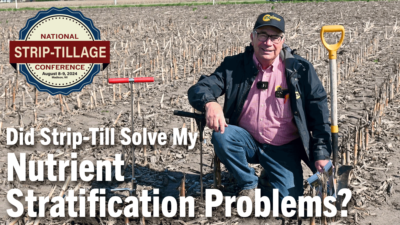Developing a strip-till system isn’t an easy process. Just ask Brian Watkins who took nearly 15 years to confidently transition from no-tilled corn to strip-till, on his 7,000 acre operation near Kenton, Ohio.
One of the biggest hurdles was always getting strips built in fall, due to the area’s typically late, wet weather. About 4 years ago, Watkins came up with a solution. He purchased a 60-foot Progressive toolbar and mounted 24 Yetter 2987 high-speed Magnum fertilizer coulters on the bar to apply potassium (K) and phosphorus (P) in the fall, using a Montag dry fertilizer air-delivery system.
He would then make a spring strip-till pass using a Wil-Rich toolbar with 24 Dawn Pluribus row units to freshen the strips and apply a small amount of nitrogen (N) ahead of planting.
While the system worked well, Watkins — who meticulously manages the ROI of his strip-till system — saw the potential to further improve upon his fertilizer application practices and make better use of equipment.
This spring, he’s going to experiment with a new strip-till setup: a Harvest International toolbar with 24 Yetter Magnum single-disc fertilizer coulters, Dawn Gfx hydraulic floating row cleaners followed by a single coulter with 2 smaller sealing coulters for liquid fertilizer application.
The biggest modification though, is a switch to a John Deere air seeder cart that will be pulled behind the strip-till bar and used for dry fertilizer application of N, P and K.
“We think it’s a pretty unique setup, and our goal is to utilize some of our equipment for more than one season,” Watkins says. “With the air cart, we’ll have more flexibility to apply fertilizer in spring, then use it to seed small grains and plant cover crops in fall.”
Watkins’ plan is to variable-rate apply N, P and K 3-5 inches beneath the soil using the Magnum coulters. However, one potential challenge with the setup is being able to apply larger amounts of dry fertilizer in areas that may need it.
“Typically, we are around a couple hundred pounds per acre, but based on management zones and soil test results, there may be areas that require more,” Watkins says. “The question is whether we can up the rates to 300-400 pounds.”
Watkins is optimistic that the system will succeed, and he’ll be sharing his experience and results during a classroom presentation at the National Strip-Tillage Conference on Aug. 3-4 in Bloomington-Normal, Ill.
What fertilization modifications are you planning to your strip-till system this spring? Share your story and contact me at (262) 777-2441, or send me an email at jzemlicka@lessitermedia.com.







Post a comment
Report Abusive Comment